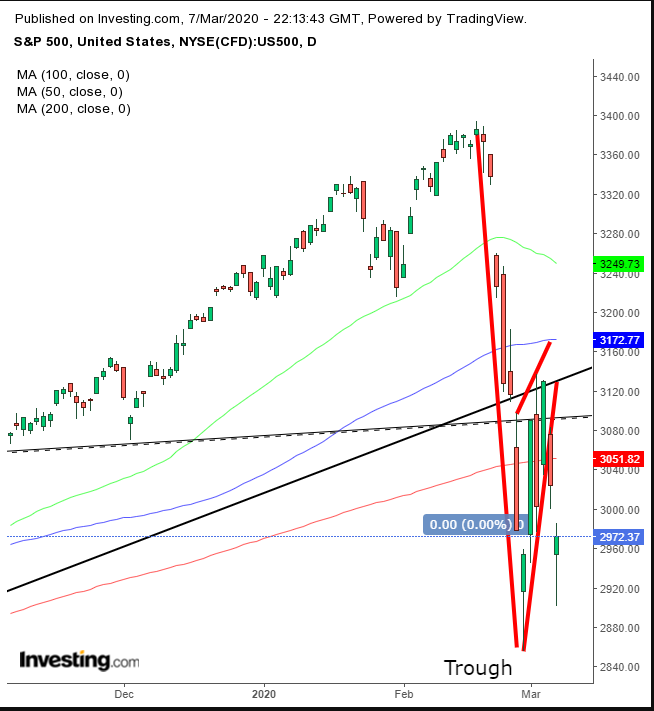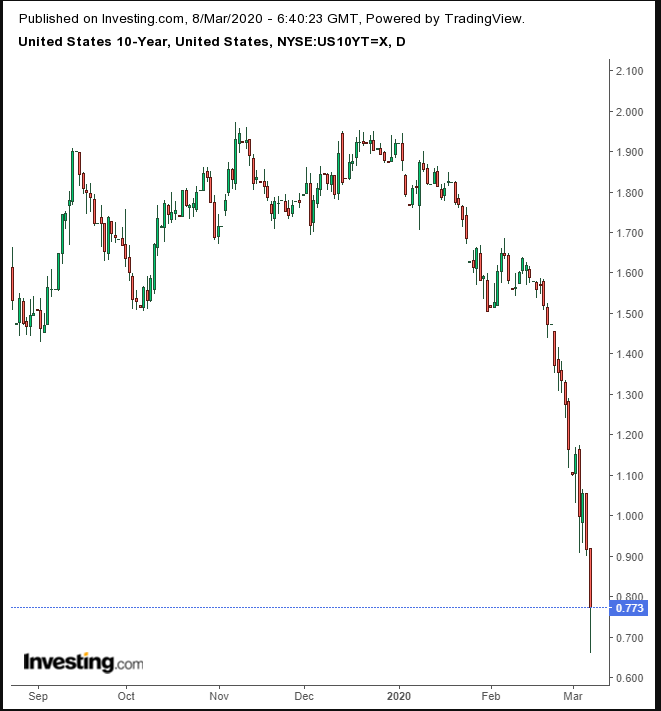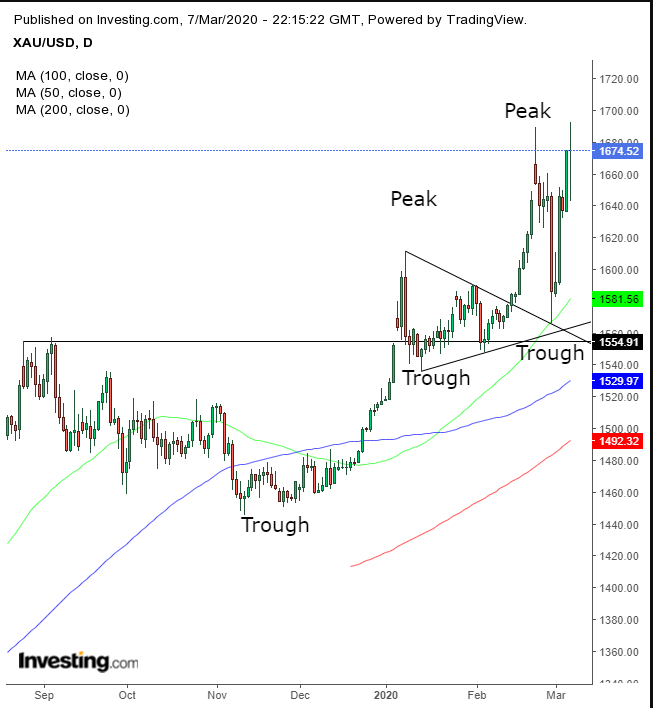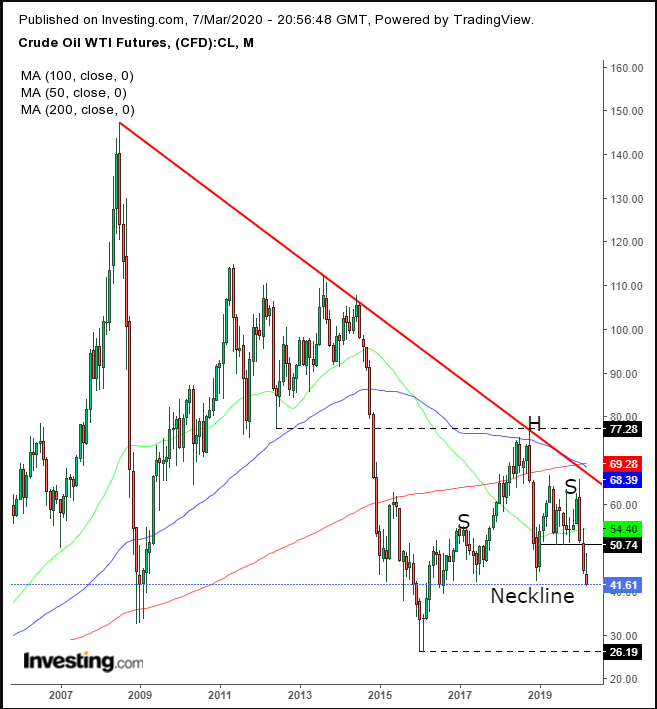- Coronavirus fears resume, rattling markets at close of trading week
- Dollar, yields slide
- Oil plunges
Investors remain fearful, notwithstanding last Tuesday's emergency rate cut by the Federal Reserve, a move predicted by some analysts. Unfortunately, it only exacerbated investor concerns, by signaling to many that the U.S. central bank was panicking, and led to an immediate sell-off that continued through the week.
Perhaps more worrying, it took off the table future tools the Fed might be able to use to counter any recessionary problems that could be upcoming from coronavirus-fueled business or manufacturing slowdowns. It also pushed Treasury yields to historic new lows, which, though still in positive territory are now below 1%.
As well, though a surprisingly robust nonfarm payrolls release on Friday showed 273,000 new jobs were created in February, the Covid-19 scare has more than offset the positive numbers. After the print, the dollar resumed a decline to a yearly low and stocks sold off for the second day.
Last Minute Rally Signaling Panic-End?
The S&P 500 Index fell on Friday, for a second day.

However, a raging rebound in the last hour of the session, trimmed the 4% plunge to 'just' 1.7%, a moderate loss these days. Moreover, the last-minute rally saved the weekly result from becoming negative, it flipped to a 0.6% advance, avoiding what would have been a third weekly drop.
Does the pause in weekly sell-offs signify an end to the coronavirus anxiety? We don’t think so. The tumultuous week, in which markets zigzagged between gains and losses daily—up until Friday, which extended Thursday's decline to a second day—is textbook market behavior following a sharp drop, such as the one that preceded the congestion.
Even after the rebound, Friday’s drop was a downside breakout to a rising flag, bearish following the 15% neck breaking plunge in the six day period between Feb. 20 and 28. Friday’s imperfect (upper shadow) hammer confirms the Feb. 28 hammer in the support of interested parties who remember the 20% surge since the August lows.
About two thirds of such breakouts are followed by a return move that retests the pattern. Analysts are currently recommending taking advantage of what they characterize as a buying dip, but we're not convinced a bottom is at hand.

The yield on the U.S. 10-year Treasury carved out a new low at 0.66% and closed at 0.77%.
The U.S. dollar slid for the sixth out of seven days to finish the week, hitting its lowest level since March 20.

Gold formed a high wave candle, confirming the resistance of the Feb 24th shooting star, increasing the probability of a second return move to retest the bullish pennant.
WTI crude prices tumbled, down 9.35% to $41.61, after OPEC's supply cut pact with Russia collapsed on Friday. Russia sacrificed Saudi Arabia to grab market share away from U.S. shale producers. The drop was the biggest one-day dive since 2014 and the lowest level for oil since 2016. Brent Crude suffered its biggest one-day loss since 2008, falling more than 9% to about $45.27 a barrel.

The price of oil might be setting up to complete a 4-year-old H&S continuation pattern, whose implied target would retest the $26.05 low reached in February 2016.
Week Ahead
All times listed are EST
Sunday
18:50: Japan – GDP: expected to edge down to -1.7% from -1.6% QoQ.
Monday
20:30: China – PPI: anticipated to have fallen to -0.3% YoY in February, after rising 0.1% the month previous.
Tuesday
18:00: South Korea – Unemployment Rate: numbers could be heavily skewed lower for February based on the coronavirus spread, now affecting more than 7,000 residents of the Asian nation; previously the rate was 4%.
Wednesday
4:30: UK – GDP: seen to retreat to 0.2% from 0.3%.
4:30: UK – Manufacturing Production: likely rise to 0.5% from 0.3%
730: U.S. – Core CPI: expected to remain flat at 0.2%.
9:30: U.S. – Crude Oil Inventories: anticipated to show a stockpile of 2.947M vs. 0.785M previously.
Thursday
8:30: U.S. – PPI: forecast to fall to -.01% from 0.5%.
8:45: Eurozone – ECB Interest Rate Decision: expected to remain at 0.00%.
8:30: Eurozone – ECB Press Conference
Friday
10:00: U.S. – Michigan Consumer Sentiment: predicted to have fallen to 95.0 in March from 101.0 in February.
